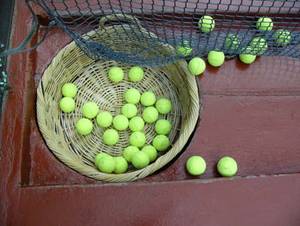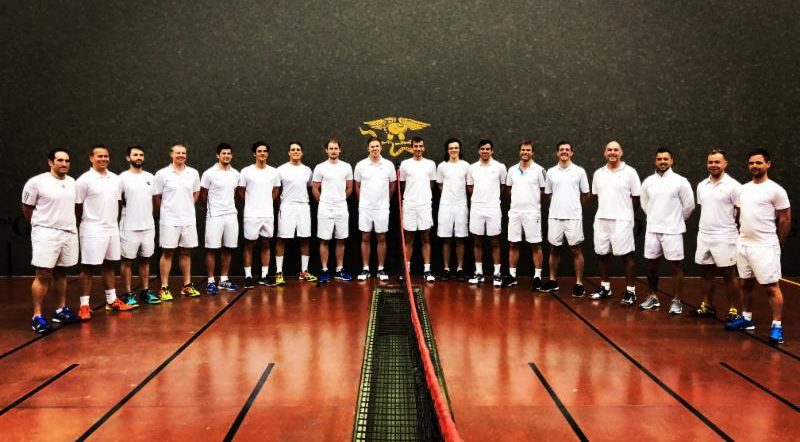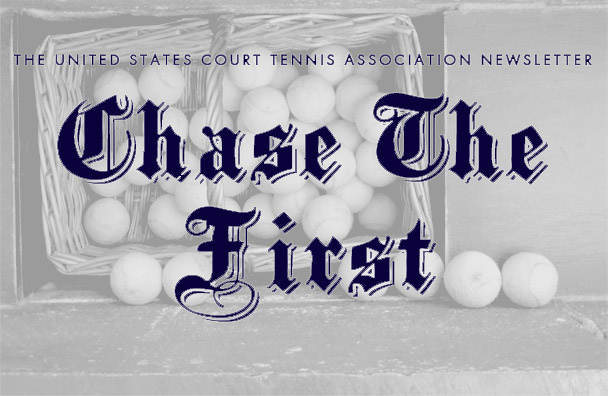The Stroke: The challenge of striking the ball cleanly in court tennis, where the game is played with wooden racquets and balls of felt hand-sewn over solid cores, is far greater than in tennis or squash. The classic stroke is a slicing shot, which places the ball low and makes a good return difficult. Skilled players are able to put a variety of spins on serves and strokes. A flat stroke may also be used but topspin is not typically employed, being not particularly effective in most game situations.
Object of the Game: The object of the game, like the game of lawn tennis, is to win “sets” of six games. As in lawn tennis, game scoring is 15-30-40-game with deuce/ad. However, unlike lawn tennis, it is sufficient to win a set by a game score of 6-5, and tiebreaks are not used.
Winning Points: Any shot that is struck which fails to clear the net or which goes out of court (including striking walls above a certain height, or the roof) results in a lost point. Points can also be lost while playing off chases (see below).
Service: Unlike lawn tennis, the ball is always served from the same side of the court, called the “service end.” [It is a tremendous advantage to be on this end, although it is possible to win points and games from either end.] The serve itself must be struck from behind the second gallery line, touch the receiver’s side of the penthouse (sloping roof) at least once, then land in the service box marked on the floor. Over the centuries more than 50 different serves have been invented, each of which may be useful against different opponents or at different points in the game.
The serving player must defend a large gallery opening at the back, called the “dedans”: when a ball is struck into this opening, the striker wins the point immediately.
The side of the court on which service is always received is known as the “hazard end” (perhaps because of the many targets the serving player has available to shoot at!). These targets include “winning openings” — the “grille” and the “winning gallery” — which are instant point winners when struck, and the “tambour,” which is an angled section of wall that redirects the ball unpredictably.
Chases: If a ball in play is allowed bounce a second time beyond the service line on the hazard end, the point is also lost. However, whenever a ball in play bounces a second time anywhere on the floor (either side) marked with lines, a “chase” is created. The position of the bounce is noted and announced. A chase may also be created by striking a ball into the other wall openings, or “galleries” (e.g., last gallery, second gallery, the door, or first gallery).
The chase is an important part of the game because it is only through the creation of a chase that the player on the “hazard end” can get to the strategically preferable “service end.” Typically, a player receiving serve wants to create a chase to gain the advantage of the service end; for this reason, the serving player may often choose to purposely lose a point rather than give up a chase.
A change of ends occurs either when there is a chase and game point has been reached (e.g., 40-15) or whenever there are two chases. Chases are resolved in the order of their creation immediately after the players change ends. To win a “chase,” the player must hit the ball over the net and force an error from his opponent, or achieve a second bounce “better” than that created by his opponent (between the chase mark previously established and the back wall). Once resolved, the point is awarded to the winning player and the “chase” disappears.” If the second bounce lands precisely where the chase was marked, the point is nullified (“chase off”).
Marking: “Marking” refers to keeping score, noting where chases are created and judging whether chases are “won” or “lost” upon being played out. In recreational matches, players typically mark themselves. However, court tennis professionals mark matches during tournament play or under other special circumstances.
In keeping score, the score of the player who won the last point is always announced first. This differs from lawn tennis, where the server’s score is always announced first.



